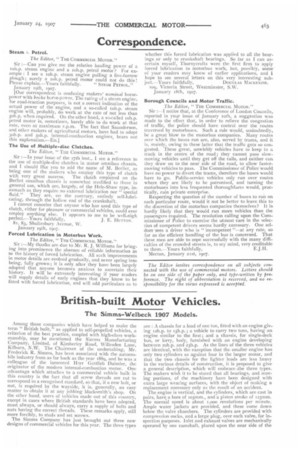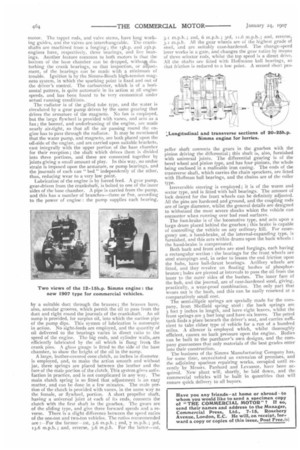British-built Motor Vehicles.
Page 19

Page 20

If you've noticed an error in this article please click here to report it so we can fix it.
The Simms-Welbeck 1907 Models.
Among those companies which have helped to make the term " British built," as applied to self-propelled vehicles, a criterion of the best practice, coupled with high-class workmanship, may be mentioned the Simms Manufacturing Company, Limited, of Kimberley Road, Willesden Lane, Kilburn, N.W. The Chairman of the undertaking, Mr. Frederick R. Simms, has been associated with the automobile industry from as far back as the year 1889, and he was a colleague of the lamented Herr Gottlieb Daimler, the originator of the modern internal-combustion motor. One advantage which attaches to a commercial vehicle built in this country is the fact that all screw threads are cut to correspond to a recognised standard, so that, if a new bolt, or nut, is required by the wayside, it is, generally, an easy matter to obtain it at any jobbing blacksmith's shop. On the other hand, users of vehicles made out of this country, except in cases where British standards have been adopted, must always, or should always, carry a supply of bolts and nuts having the correct threads. These remarks apply, still more forcibly, to studs and set screws.
The Simms Company has just brought out three new designs of commercial vehicles for this year. The three types
are : A chassis for a load of one ton, fitted with an engine giving 12h.p. to 1511.p.; a vehicle to carry two tons, having an engine similar to the first ; and a chassis, for single-deck bus, or lorry, body, furnished with an engine developing between 2oh.p. and 25h.p. As the lines of the three vehicles are identical, with the exception that the smaller engine has only two cylinders as against four in the larger motor, and that the two chassis for the lighter loads are less heavy in the various details of construction, it is proposed to give a general description, which will embrace the three types. The makers wish it to be stated that all bearings, and moving portions, of the machinery have been designed with extra large wearing surfaces, with the object of making a replacement necessary only as the result of an accident. The engine is vertical, and the cylinders, which are cast in pairs, have a bore of Joplin., and a piston stroke of 125mm. The normal speed is about 1,000 revolutions per minute. Ample water jackets are provided, and these come down below the valve chambers. The cylinders are provided with compression cocks, and a large plug, over each valve, for inspection purposes. Inlet and exhaust valves are mechanically operated by one camshaft, placed upon the near side of the
motor. The tappet rods, and valve stems, have long working guides, and the valves are interchangeable. The crankshafts are machined from a forging ; the 15h.p. and 25h.p. engines have, respectively, three bearings, and live bearings. Another feature common to both motors is that the bottom of the base chamber can be dropped, withouA disturbing the crank bearings, so that inspection, or adjustment, of the bearings can be made with a minimum of trouble. Ignition is by the Simms-Bosch high-tension magneto system, in which the sparking point is fixed and out of the driver's control. The carburetter, which is of a horizontal pattern, is quite automatic in its action at all engine speeds, and has been found to be very economical under actual running conditions.
The radiator is of the gilled tube type, and the water is circulated by a gear pump driven by the same gearing that drives the armature of the magneto. No fan is employed, but the large flywheel is provided with vanes, and acts as a fan ; the bonnet, and underframing of the engine, arc made nearly air-tight, so that all the air passing round the engine has to pass through the radiator. It may be mentioned that the water pump, and magneto, are both placed upon the off-side of the engine, and are carried upon suitable brackets, cast integrally with the upper portion of the base chamber for their reception; the shaft which drives them is divided into three portions, and these are connected together by joints giving a small amount of play. In this way, no undue strain is imposed upon the armature, or pump bearings, and the journals of each can " bed " independently of the other, thus, reducing wear to a very low point.
Lubrication of the engine is by forced feed. A gear pump, gear-driven from the crankshaft, is bolted to one of the inner sides of the base chamber. A pipe is carried from the pump, and this has a number of branches—three or five, according to the power of engine : the pump supplies each bearing, by a suitable duct through the brasses ; the brasses have, also, annular grooves, which permit the oil to pass from the duct and right round the journals of the crankshaft. An oil sump is provided, for surplus oil, into which the suction pipe of the pump dips. This system of lubrication is automatic in action. No sight-feeds are employed, and the quantity of oil delivered to the bearings varies in direct ratio to the speed of the engine. The big ends, and cylinder walls, are efficiently lubricated by the oil which is flung from the crank pins. A glass gauge is fitted to the side of the base chamber, to show the height of the oil in the sump.
A large, leather-covered cone clutch, 20 inches in diameter, is employed, and, to make the action smooth and without jar, three springs are placed between the leather and the face of the male portion of the clutch. This system gives satisfaction in practice, and is not complicated in any way. The main clutch spring is so fitted that adjustment is an easy matter, and can be done in a few minutes. The male portion of the clutch is provided with vanes, in the same way as the female, or flywheel, portion. A short propeller shaft, having a universal joint at each of its ends, connects the clutch with the first shaft in the gearbox. The gears are of the sliding type, and give three forward speeds and a reverse. There is a slight difference between the speed ratios of the one-ton and two-ton vehicles. The ratios recommended are :-For the former-1st, 3.6 m.p.h. ; znd, 7 m.p.h. ; 3rd, 13.6 m.p.h.; and, reverse, 3.6 m.p.h. For the latter— st,
3.1 m.p.h. ; znd, 6 m.p.h. ; 3rd, 11.6 m.p.h. ; and, reverse, 3.1 m.p.h. All the gear wheels are of the highest grade of steel, and are suitably case-hardened. The change-speed lever works in a gate, and changes the gear ratios by means of three selector rods, whilst the top speed is a direct drive. All the shafts are fitted with Hoffmann ball bearings, so that friction is reduced to a low point. A second short pro peller shaft connects the gears in the gearbox with the pinion driving the differential ; this shaft is, also, furnished with universal joints. The differential gearing is of the bevel wheel and pinion type, and has four pinions, the whole being enclosed in a malleable iron casing. The ends of the transverse shaft, which carries the chain sprockets, are fitted with Hoffman ball bearings, and the chains are of the roller type. Irreversible steering is employed; it is of the worm and sector type, and is fitted with ball bearings. The amount of Lock desired for the front wheels can be definitely adjusted. All the pins are hardened and ground, and the coupling rods are of large diameter, whilst the general details are designed to withstand the most severe shocks whicn the vehicle can encounter when running over bad road surfaces.
The foot-brake is of the locomotive type, and acts upon a large drum placed behind the gearbox ; this brake is capable of controlling the vehicle on any ordinary hill. For emergency use, a hand-brake, of the internal-expanding type, is furnished, and this acts within drums upon the back wheels : the hand-brake is compensated. Both back and front axles are steel forgings, each having a rectangular section : the bearings for the front wheels are steel stampings and, in order to lessen the end friction upon the hubs, have ball-thrust bearings. Artillery wheels are fitted, and they revolve on floating bushes of phosphorbronze ; holes are pierced at intervals to pass the oil from the inner to the outer sides of the bushes. The inner face of the hub, and the journal, are of case-hardened steel, giving, practically, a wear-proof combination. The only part that wears out is the bush, and this can be easily renewed at a comparatively small cost. The semi-elliptic springs are specially made for the company, from Sheffield spring steel : the back springs are 3 feet 7 inches in length, and have eight leaves, whilst the front springs are 3 feet long and have six leaves. The petrol tank finds a place beneath the driver's seat, and carries sufficient to take either type of vehicle for a run of a hundred miles. A silencer is employed which, whilst thoroughly efficient, causes no back pressure upon the engine. Bodies can be built to the purchaser's own designs, and the company guarantees that only materials of the best grades enter into their construction.
The business of the Simms Manufacturing Company has, for some time, necessitated an extension of premises, and the adjoining spacious repairing works, occupied until recently by Messrs. Panhard and Levassor, have been acquired. New plant will, shortly, be laid down, and the commercial vehicles will be built in quantities that will ensure quick delivery to all buyers.
























